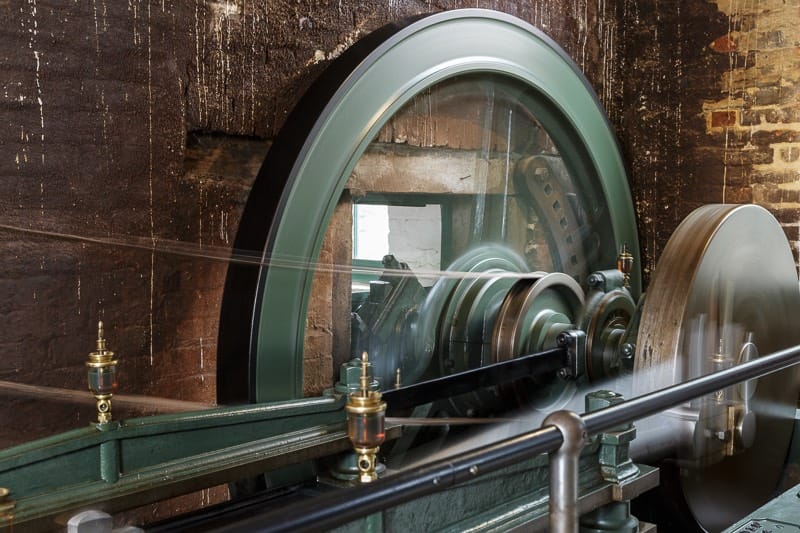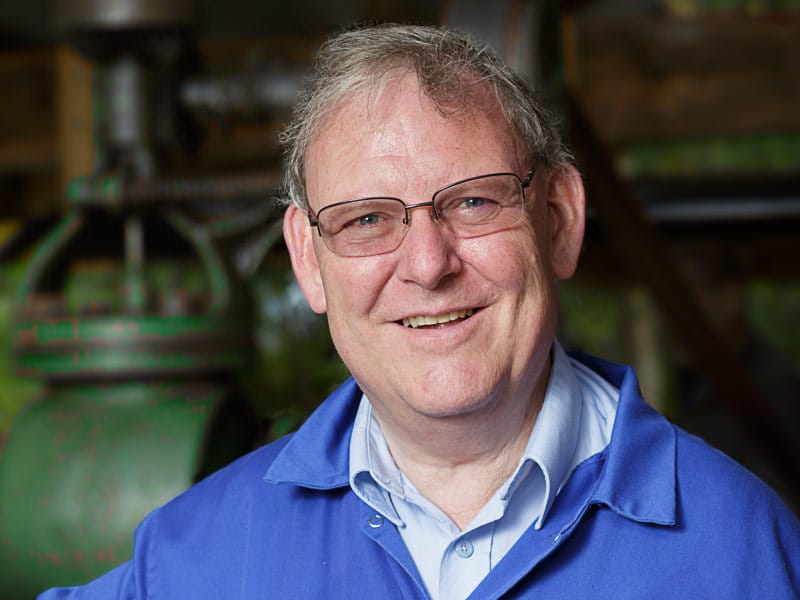We finish up our story of Bursledon Brickworks Museum volunteer Bob Palmer, with a quick…
Textile art part one – The great bra hunt
1.
Textile art part one – The great bra hunt
The inspiration for Jane’s textile pictures had to start somewhere.
With nearly twenty years’ experience of quilting, and a lifetime of interest in ‘making’ things, Jane’s small book ‘The Great Bra Hunt’ was where it all started.
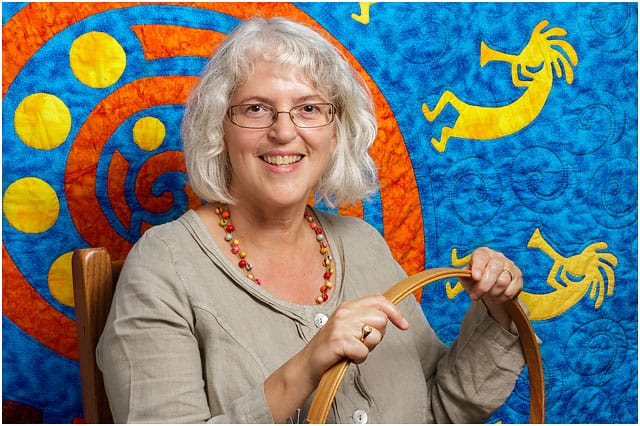
Do you have a history of, say, being a seamstress or …?
No – not at all. My mother was very good with a sewing machine, and made all our clothes. But that’s not unusual for someone of her generation. I did fine art at school and a bit more at University. I’ve always loved playing with colours. One of my favourite things was patchwork. It was brilliant not having to worry about the size and the fit, as a dressmaker has to, but just blending colours and making lovely big quilts. That was my idea of heaven.
I don’t go anywhere without the makings of a picture.
How did the textile art start?
The picture making emerged out of the clear blue sky really. I was just mucking around late one night with a few scraps of fabric and I put some sheer organza over it and thought, hey this is really neat let’s do some more. I kind of just worked it out from there. And now I’m a little bit obsessed. We’re planning to go on holiday at the end of this week and I’ll be taking along a shoebox of shards of fabric and some blank canvases. I don’t go anywhere without the makings of a picture. I also do a lot more sketching than I used to as well.
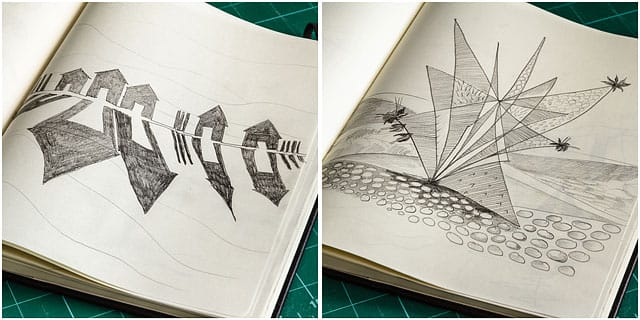
What sort of holiday is it?
We’re off to Exmoor to visit some very good friends, and have plenty of rambles over the moor with the dogs.
Are you from Exmoor originally?
No, I was born in Shropshire. I lived briefly in Rugby, but did most of my schooling in Lincolnshire. I happened to get a job on the South coast, and I’ve been here ever since. My work has not been associated with the arts at all, except for my first job where I was a lowly publicity assistant for Poole Arts Centre. Most of my working life has been in the housing industry. So the creativity was probably a way to get away from the 9-5 pressures.
Before taking up quilting did you have any other hobbies or pastimes?
I’ve always made things. My Grandmother taught me to crochet when I was knee-high. She was a real stickler for accuracy. If you made a mistake, you unpicked; you didn’t just say, ‘oh never mind’. So that was the first thing that I did. Again, it was all about colour and texture. I just always made things really, always
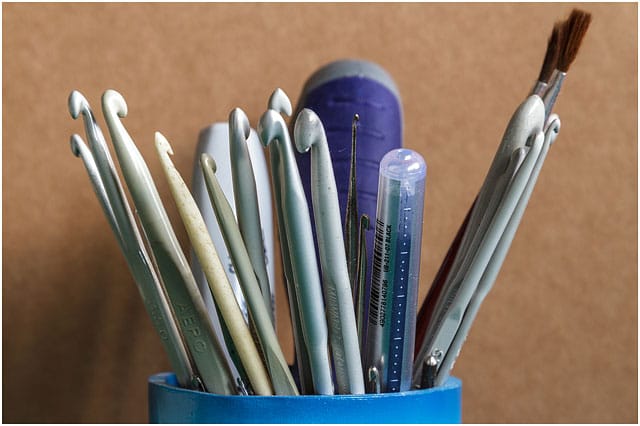
As you know I found you via Caroline – what’s your association with her?
Well, Caroline [Hounsell] runs Breakaway Quilters, and she’s been a good friend for a lot of years now. We were both members of another quilt group, which has since disbanded.
Some of us from the evening sessions, at the earlier group, wanted to continue after it had disbanded. So we got together and Caroline, along with her friend Christine, started up the Breakaway Quilters. We’ve been going for about four or five years now. I’ve lost track, to be honest.
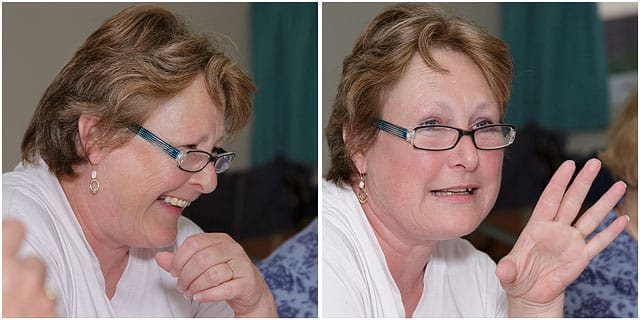
Caroline’s a wonderful person because she will always seek an opportunity on behalf of somebody else. She’s marvellous at doing that. I know that when you made contact, she immediately thought of somebody else outside of the Quilting group who might be of interest for your photography project. (Another lady who, thanks to Caroline, will be featured in a future Weekend Passions article on ‘Batala’, a Reggae Samba drumming band).
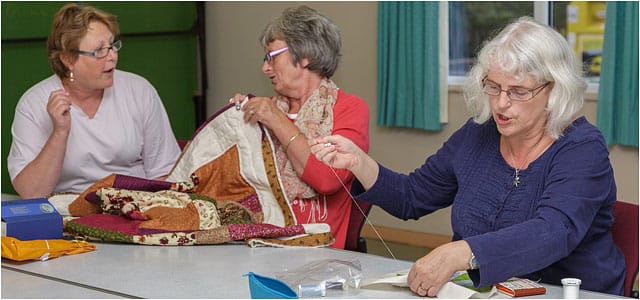
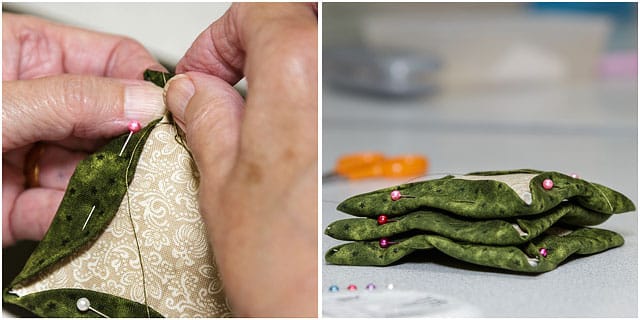
Did you know Caroline before you started quilting?
No, we met through quilting. I’ve made a lot of good friends through the Breakaways. We meet every Wednesday, 7 o’clock, at Denmead Community Centre and you really couldn’t wish to have a friendlier group of like-minded ladies. We basically just bring our work along and have a natter with a cup of tea. There’s no pressure or competition, and everyone helps each other. If someone is ‘blocking out’ a quilt top, they will bring it along evening and we all muck in to help. It’s quite a task for just one person since some of them can be around 7ft square or even bigger.
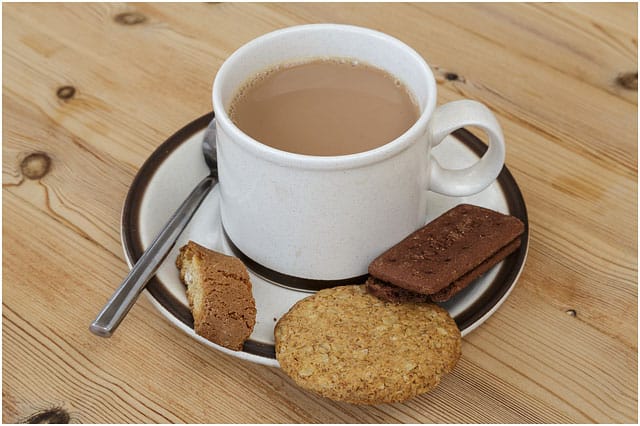
How many members are there in the Breakaway Quilters group?
Eighteen at the moment, but they don’t all come each week. We have a mixture of younger and older ladies, and we all rub along together very well. New members are always welcome. We’re not a teaching group, as such, although we try to help each other out, as I’ve said. We’re always thrilled to bits when someone has finished a quilt and we’ll have a bit of a ‘show and tell.’
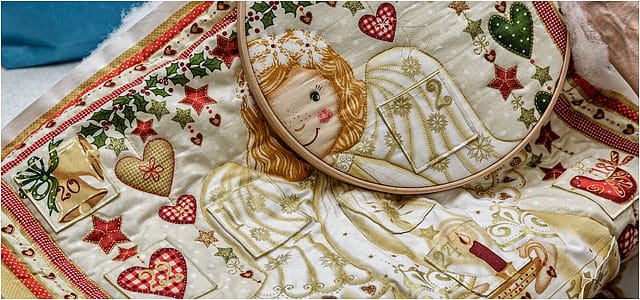
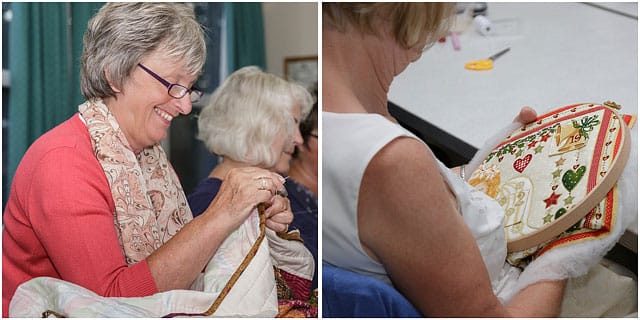
Some of our members belong to other groups as well, which is great, because it ensures that there are lots of ideas floating around.
New members are always welcome
Is there a membership fee?
We all pay £3 a week to cover the cost of hiring the hall, public liability insurance, and extras, such as the tea and coffee, etc.
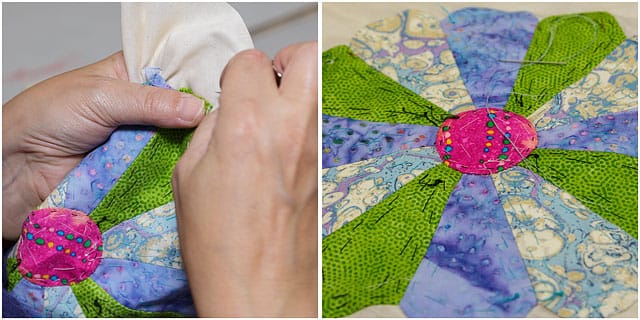
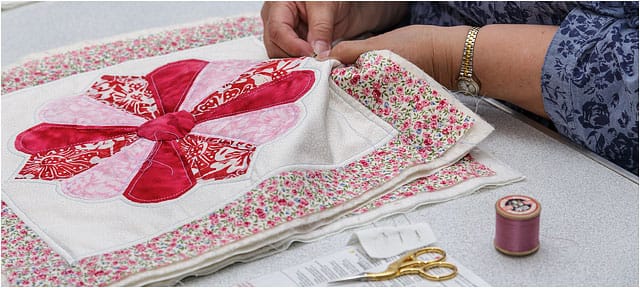
The great bra hunt
What was the inspiration for your book ‘The Great Bra Hunt’?
It was supposed to be after the style of a Victorian animal hunter or something. It was a lot of fun to write. The basic premise was that the ‘brassiere’ was a living breathing creature that actually had to be captured and trained. This was all because I had a friend that had an unusual cup size, and could never, ever, find a bra that was right for her. I used to spend hours in Marks & Spencers, thinking, ‘for God’s sake Cathy, there has to be something in your size in organic cotton, because I’m getting fed up with this!’ The Great Bra Hunt story was my survival strategy to get me through the boredom. I imagined all the little bras coming out of their boxes at night and flying around the shop. It was all in my head at first, then, as it grew, I committed it to a notebook as scribbles and ideas. There was no real grand plan, it just took on a life of its own.
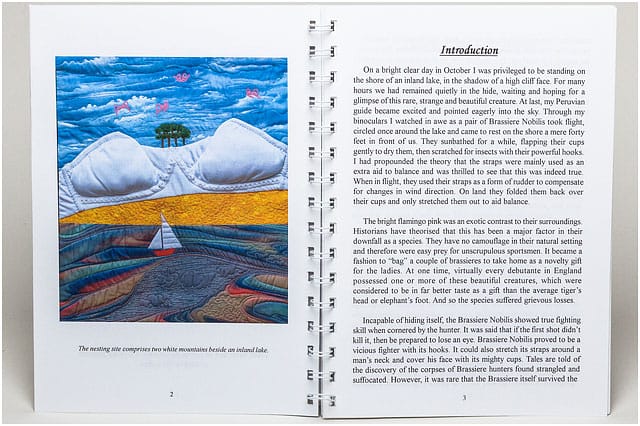
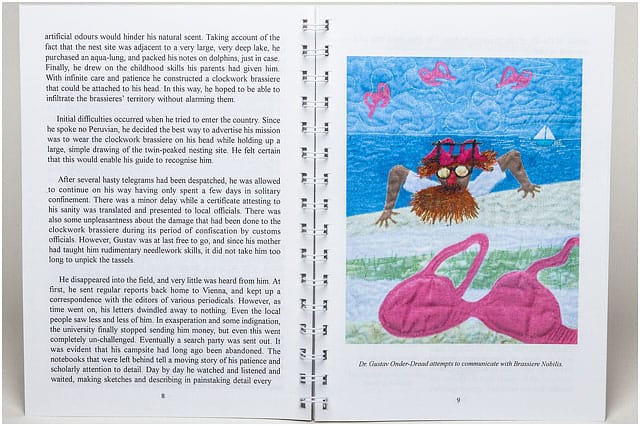
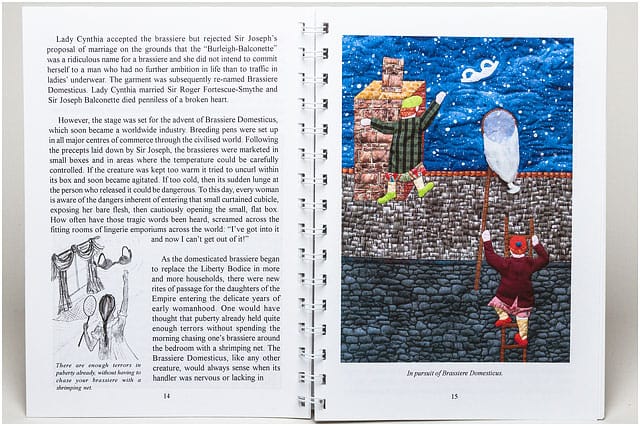
What happened when you finished the book?
As a result of this booklet, I had an exhibition of textile art, with all these pictures made up of various bras. My friend Cathy now actually owns most of them. I made a lot of them into cushions and gave them to her. The most fun part was writing my own reviews, which are on the back. I really enjoyed that, I often wonder who reviews books and why. So I decided to review my own.
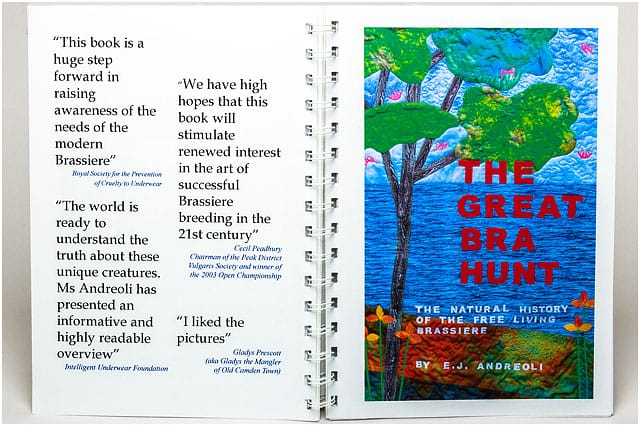
Tell me a little bit about the exhibition.
It struck me, as I neared the end of writing the book that it would be good fun to show off the artwork that I’d created. A few friends suggested having an exhibition and I thought why not? Nobody is going to give me permission, so I’ll give it to myself and just do it. So I hired this little gallery in Dulverton, on Exmoor. My best friend, who lived locally, went round with her mum and did all the publicity for me. They were just amazing and I’m indebted to them for that. I added a few quilts that I’d designed and made, during the time that I was writing the book, to round it out a bit. It went really well.
But the thing is, there weren’t enough illustrations and quilts to actually fill the walls. So I started messing around with some scraps of fabric and produced these textile pictures. I thought “I’ll stick those up as well.” And, blow me, they actually sold. I couldn’t believe it
When was this?
This was in 2005. So I’ve been creating textile art for nearly ten years now
All because of difficulty in finding a bra?
All because I got bored of waiting for my friend to choose a bra. That’s basically it, yep You’ll be pleased to hear that I’ve moved on from that now. I no longer collect bras!
It’s an amazing little book
It’s bizarre, is what it is ! I’ve been a patchworker and quilter for nearly twenty years now. There’s always a quilt on the go. I’ve got one on the frame downstairs at the moment. That’s kind of the base thing of what I do. I’ve got to have something in my hands to sew, but there are always masses and masses of bits left over. You know artists have their palette of colours, well this is my palette. All these material scraps.
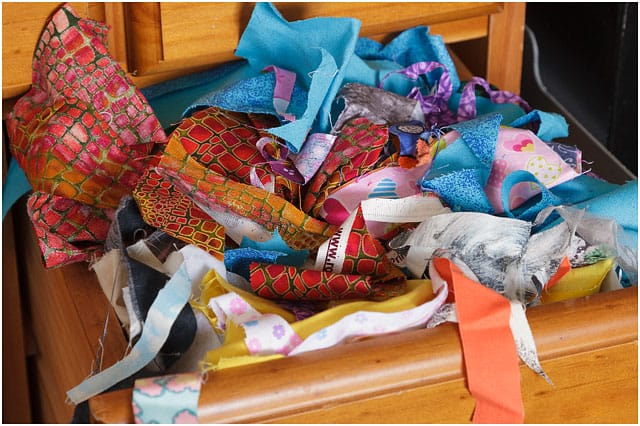
Jumping through hoops with kokopelli
What’s the history of quilting?
They actually found quilts in the pyramids in Egypt. Just about every country in the world has got its own history. There’s no one country that can lay claim to it. Everyone thinks of quilts as being American. They have an amazing quilting tradition of course, but the Brits also have their own, as well. Durham quilting is a good example.
Now, imagine that you are absolutely skint. You haven’t got very much in the way of fabric, maybe a couple of sheets in two different colours. Even with these limitations, some astonishing work can be done. If you cut the sheets into strips and sew them together, the beauty can be in the actual quilting itself, because you can quilt intricate designs in each strip. The designs are not only beautiful in their own right, but they hold together the backing and the wadding, which is what makes a quilt strong and warm.
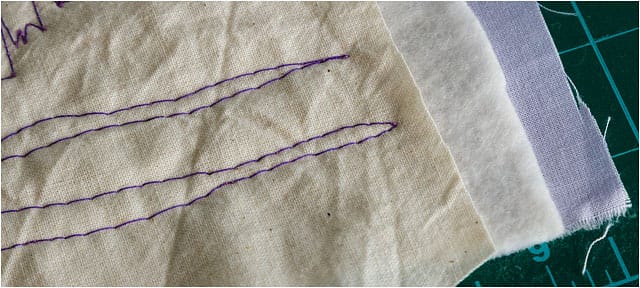
Are they machined, or hand stitched?
I sewed the quilt top together on the sewing machine and then quilted it by hand, in what we call ‘quilting in the ditch’. This is the technique of quilting, along all the seams, to minimise how much thread shows on the uppermost layer.
I like hand quilting. A lot of the ladies in the Breakaway group are very skilled machine quilters, but I’m not one of them. I use a machine for my pictures, but I always think of that as drawing with a needle. You can see some fabulous examples of large-scale machine-quilting, but for bed quilts, I would rather use my hoop.
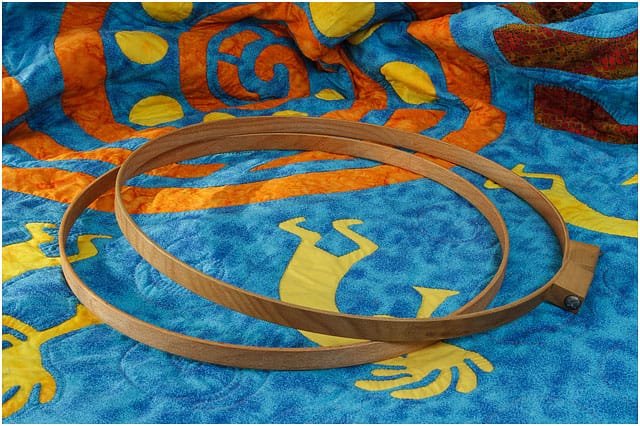
What is a hoop?
A hoop is used to hold the three layers of the quilt together and keep them flat as you hand-stitch them together.
This is a quilt that I designed myself. It’s supposed to express what it feels like to listen to a good saxophone player. They are actually Kokopelli figures, downloaded from the Internet, God bless Google. I wanted this great big spiral to represent the sort of whaaaaaaa sound from a saxophone.
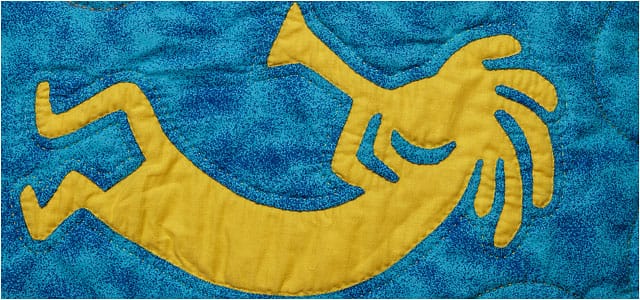
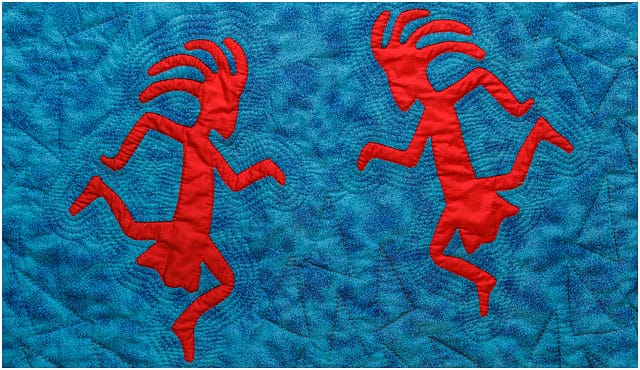
Is a common style of working?
This was done using a technique called reverse appliqué. I started with a large piece of fabric that I drew all my designs on. Then I tacked fabric on contrasting colours underneath and cut through the top to reveal the fabric below. The edges are turned over to tidy them up. Of course, you have to get it right first time, otherwise you’re stuffed.
Here you can see the three layers that we talked about earlier. Backing, wadding and top. This one has heavier weight wadding, for extra warmth, because it’s for an elderly person.
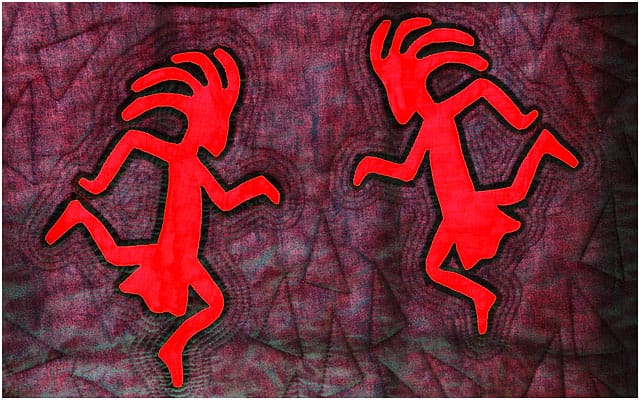
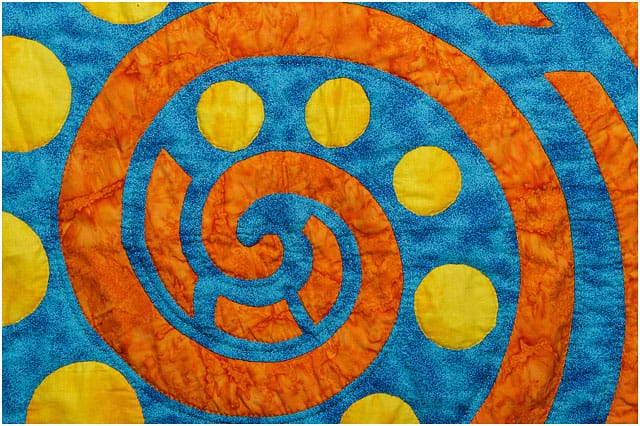
REF: Kokopelli
Kokopelli is a fertility deity, usually depicted as a humpbacked flute player (often with feathers or antenna-like protrusions on his head), who has been venerated by some Native American cultures in the Southwestern United States. Like most fertility deities, Kokopelli presides over both childbirth and agriculture. He is also a trickster god and represents the spirit of music.
Kokopelli is a fertility deity, usually depicted as a humpbacked flute player (often with feathers or antenna-like protrusions on his head), who has been venerated by some Native American cultures in the Southwestern United States. Like most fertility deities, Kokopelli presides over both childbirth and agriculture. He is also a trickster god and represents the spirit of music.
How long would something like this take you to do?
A few months, depending on how much time I give to it on a daily basis. One hour or more, if I’m able. I don’t want this to be too densely worked. The more you quilt it, the stiffer it becomes and in this case I want a relatively soft final piece.
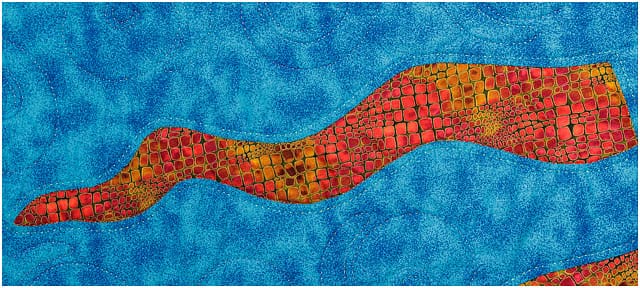
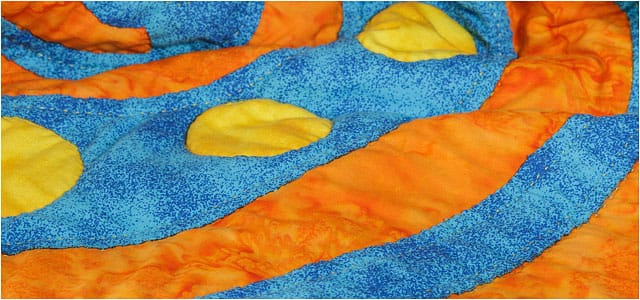
Do you use specialist tools?
No, just dressmaking scissors for cutting. Quite honestly, the fewer gadgets the better. The only gadgets that I use, are the quilting hoop and a pair of thimbles.
The final stage of a quilt is a bit like painting by numbers for me. Even if I’ve designed it myself, there comes a point when you end up with a set design to follow. Once you get to that stage, it’s a case of just getting it finished, and there’s no more creativity involved. Whereas, with the textile pictures, they are quick, spontaneous, and you can have a lot more fun.
Any special type of thread?
Nothing particularly fancy. They are just normal dressmaking threads. The larger spools tend to be for hand quilting, as they are slightly thicker yarn.
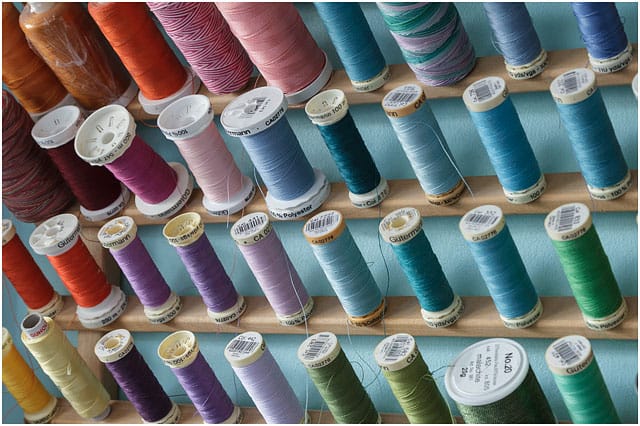
Stay tuned for part two where we get to see, and talk about Jane’s Textile picture art and magazine article submissions.
Web Links and References of interest
Jane’s website
http://www.ejatextileart.co.uk/
Caroline Hounsell’s blog (for further information about the Denmead quilting group)
http://carrieandthebreakaways.blogspot.co.uk/

